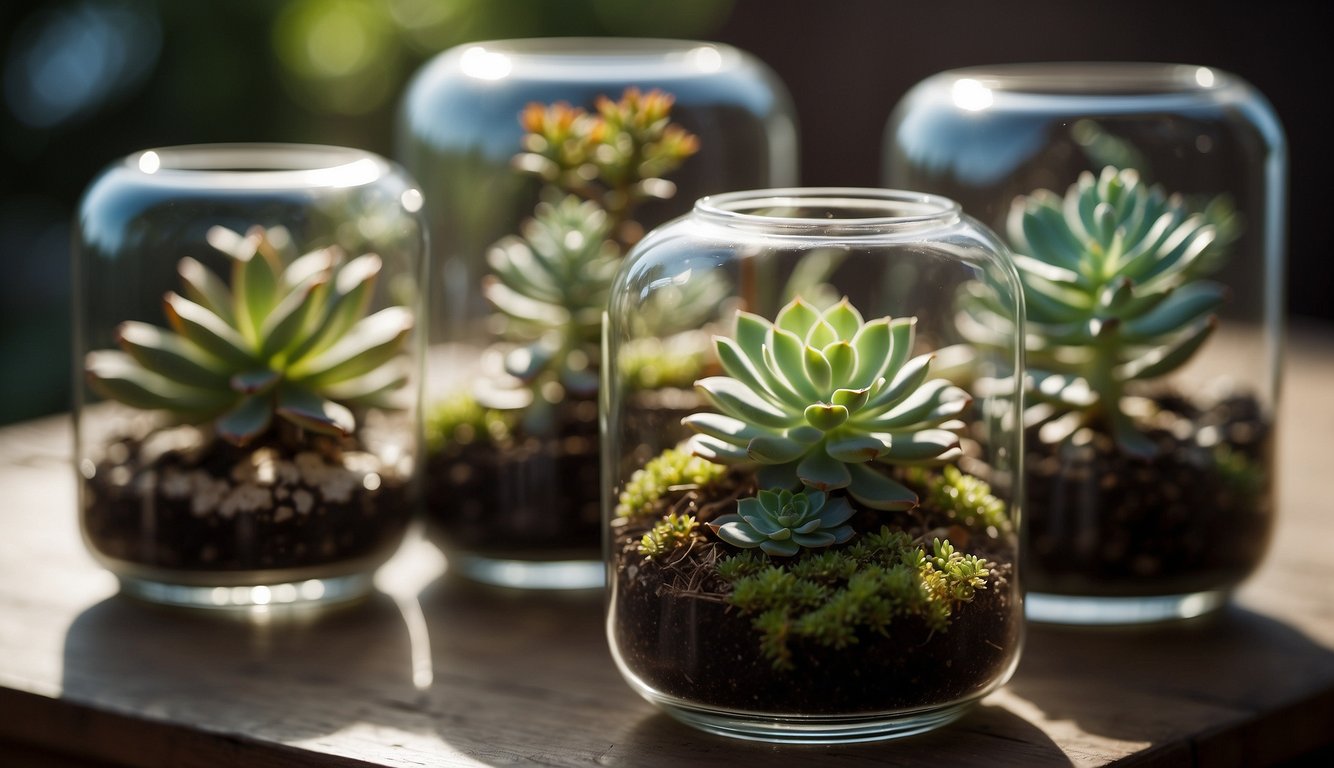TheHerbProf.com is a treasure trove of knowledge for those interested in natural healing and herbal remedies. The website is run by Paul Johnston MD. A naturopathic who has not only received extensive education in the field but also has personal experience in self-healing.
Propagating succulents in water is a popular method of growing new plants from cuttings. It is a simple and easy process that can be done by anyone, regardless of their gardening experience. This method involves using water as a medium to root the cuttings, rather than soil.
One of the advantages of propagating succulents in water is that it allows you to see the roots as they grow. This can be a fun and educational experience, especially for children. Additionally, you don’t have to worry about overwatering or underwatering your plants, as the water provides a consistent source of moisture. However, it is important to note that not all succulents can be propagated in water, and some may take longer to root than others.
If you’re interested in propagating succulents in water, there are a few things you’ll need to get started. You’ll need a clean container, fresh water, and a healthy succulent cutting. It’s also important to choose the right type of succulent for water propagation, as some species are more suited to this method than others. With the right materials and a little patience, you can successfully propagate your own succulent plants in water.
Understanding Succulent Water Propagation
Definition and Benefits of Water Propagation
I have found that water propagation is a simple and effective way to propagate succulent plants. Water propagation is the process of growing new plants from succulent cuttings by placing them in water until roots develop. This method has become increasingly popular due to its simplicity, low maintenance, and high success rate.
One of the benefits of water propagation is that it allows you to see the roots as they develop. This makes it easier to determine when the cutting is ready to be planted in soil. Additionally, water propagation is a great way to recycle decorative cuttings or to accumulate your succulent collection without having to buy new plants.
Comparing Soil and Water Propagation
When it comes to propagating succulent plants, there are two main methods: soil propagation and water propagation. Soil propagation involves planting the cutting directly into soil and waiting for roots to develop.
While soil propagation is a reliable method, it can be more difficult to monitor root development. On the other hand, water propagation allows you to see the roots as they develop, making it easier to determine when the cutting is ready to be planted in soil.
Another advantage of water propagation is that it can help prevent overwatering, which is a common issue with succulent plants. When propagating in soil, it can be difficult to determine how much water the cutting needs, which can lead to overwatering and root rot. With water propagation, the cutting only receives the amount of water it needs to develop roots, and excess water can be easily removed.
Overall, water propagation is a simple and effective way to propagate succulent plants, and it can be a great alternative to soil propagation. By understanding the benefits of water propagation and how it compares to soil propagation, you can choose the method that works best for you and your succulent plants.
Preparation for Propagation – Propagating Succulents in Water

Before propagating succulents in water, there are a few things you need to consider. In this section, I will cover the succulent species suitable for water propagation, the tools and materials needed, and the types of water that are best for this process.
Selecting Succulent Species for Water Propagation
Not all succulent species are suitable for water propagation. Some species, such as Echeveria, Graptopetalum, and Sedum, are ideal for water propagation because they produce roots quickly. On the other hand, some species, such as Cacti, are not suitable for water propagation because they take longer to produce roots and are more prone to rotting.
Tools and Materials Needed – Propagating Succulents in Water
To propagate succulents in water, you will need the following tools and materials:
- Sharp scissors or pruning shears to take cuttings.
- A clean, clear glass jar or container to hold the cuttings.
- Distilled water or tap water that has been left out overnight to allow any chlorine to dissipate.
- A tray or saucer to hold the jar or container.
Water Quality and Types
The quality of water you use for propagating succulents is important. Tap water can contain chlorine, fluoride, and other chemicals that can harm the cuttings. It is best to use distilled water or tap water that has been left out overnight to allow any chlorine to dissipate.
It is also important to note that the type of water you use can affect the growth of the succulent. For example, hard water, which contains high levels of minerals, can cause the leaves of the succulent to turn yellow or brown. On the other hand, soft water, which contains low levels of minerals, can cause the leaves to turn a lighter shade of green.
Selecting the right succulent species, having the right tools and materials, and using the right type of water are all important factors to consider when preparing for succulent water propagation.
Propagation Process – Propagating Succulents in Water
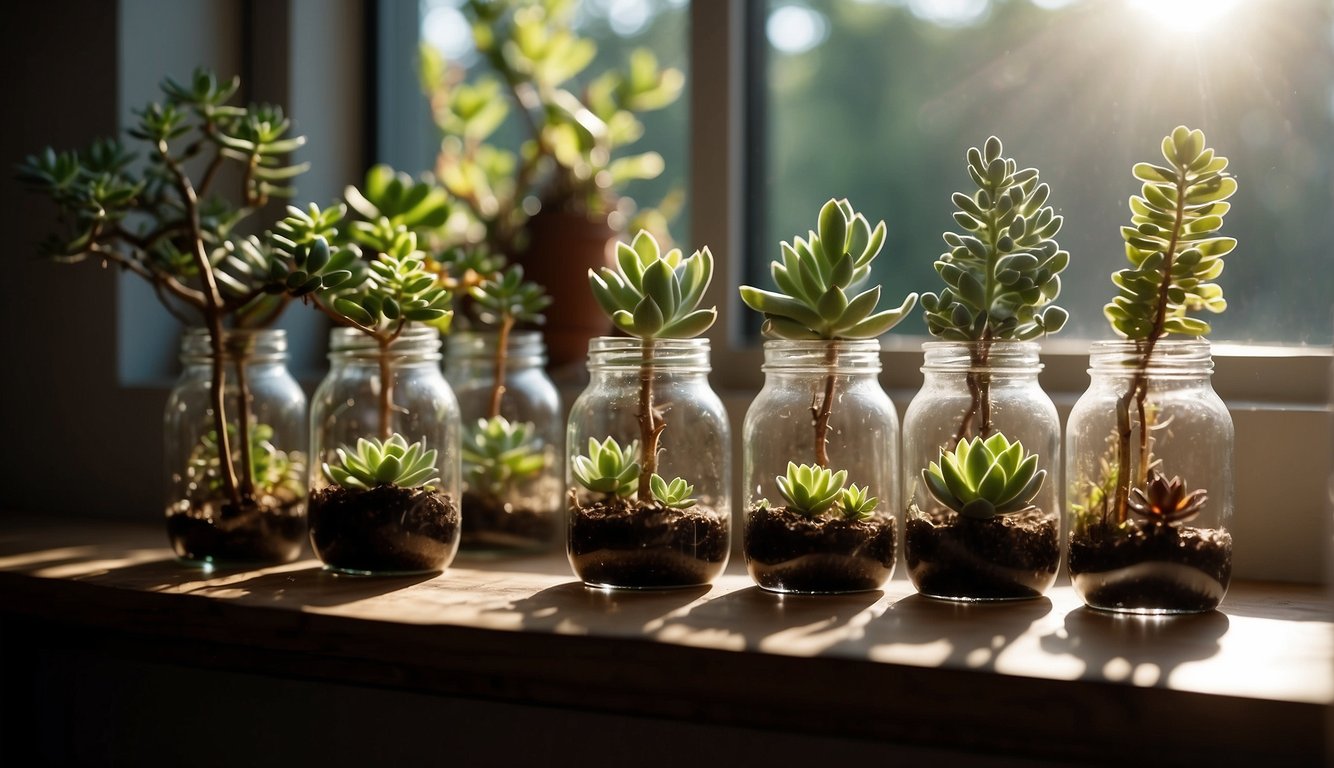
Propagating succulents in water is a simple and effective way to expand your collection. Here is a step-by-step guide to propagate succulents in water.
Taking Cuttings from the Parent Plant
The first step in the propagation process is to take cuttings from the parent plant. Use a sharp and sterilized pair of scissors or pruning shears to cut a stem cutting from the parent plant. Make sure the cutting is at least 4 inches long and has a few leaves attached to it.
Callusing the Cuttings – Propagating Succulents in Water
After taking the cutting, let it dry for a few days until it forms a callus. The callus is a dry and hardened part of the cutting that helps prevent water from entering the cutting and causing root rot. Place the cutting in a dry and shaded area to callus.
Submerging Cuttings in Water
Once the cutting has calloused, fill a glass jar or vase with clean water and submerge the cutting in the water. Make sure the water level is high enough to cover the bottom of the cutting but not too high to touch the leaves. Change the water every few days to prevent bacteria growth and maintain the water quality.
Monitoring Root Development
After a few weeks, the cutting will start to develop roots. Monitor the root development by gently tugging on the cutting. If the cutting resists, it means the roots have developed and it is ready to be potted. If the cutting comes out easily, it means the roots are not fully developed and it needs more time in the water.
Maintain the water quality and keep the cutting in a bright and shaded area to encourage root development. Once the roots have developed, pot the cutting in well-draining soil and place it in a bright and sunny area to encourage growth.
Overall, propagating succulents in water is a simple and effective way to expand your collection. By following these steps, you can propagate succulents with ease and enjoy the beauty of these amazing plants.
Caring for Propagated Succulents – Propagating Succulents in Water
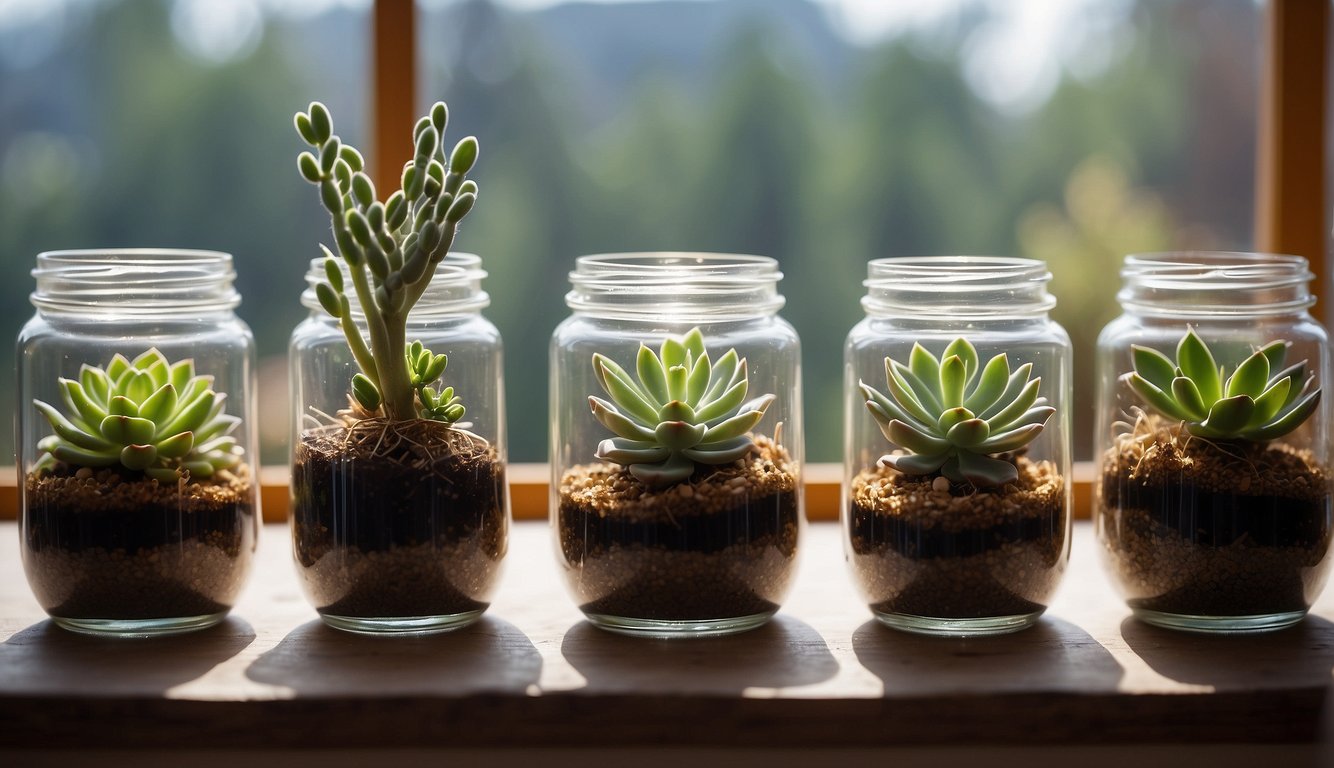
After propagating succulents in water, it is important to take good care of them to ensure their healthy growth. Here are some tips for caring for propagated succulents.
Light and Temperature Requirements
Succulents thrive in bright, indirect sunlight. Direct sunlight can scorch their leaves, so it is best to place them in a location where they will receive bright, indirect light for several hours each day. The ideal temperature range for succulents is between 60 and 80 degrees Fahrenheit. If the temperature drops below 50 degrees Fahrenheit, the succulents may become dormant and stop growing.
Changing Water and Preventing Fungus
It is important to change the water in which the succulent cuttings are propagating every few days to prevent the growth of fungus. Simply pour out the old water and refill the container with fresh water. If you notice any signs of fungus, such as a white or gray film on the leaves or stem, remove the affected parts of the plant and change the water immediately.
Transplanting to Soil
Once the succulent cuttings have developed roots, they can be transplanted to soil. Use a well-draining cactus soil mix and add perlite to improve drainage. Gently remove the cuttings from the water and plant them in the soil, making sure to cover the roots completely. Water the newly planted succulents sparingly for the first few weeks until they become established.
By following these simple tips, you can ensure that your propagated succulents will thrive and grow into healthy, beautiful plants.
Troubleshooting Common Issues – Propagating Succulents in Water
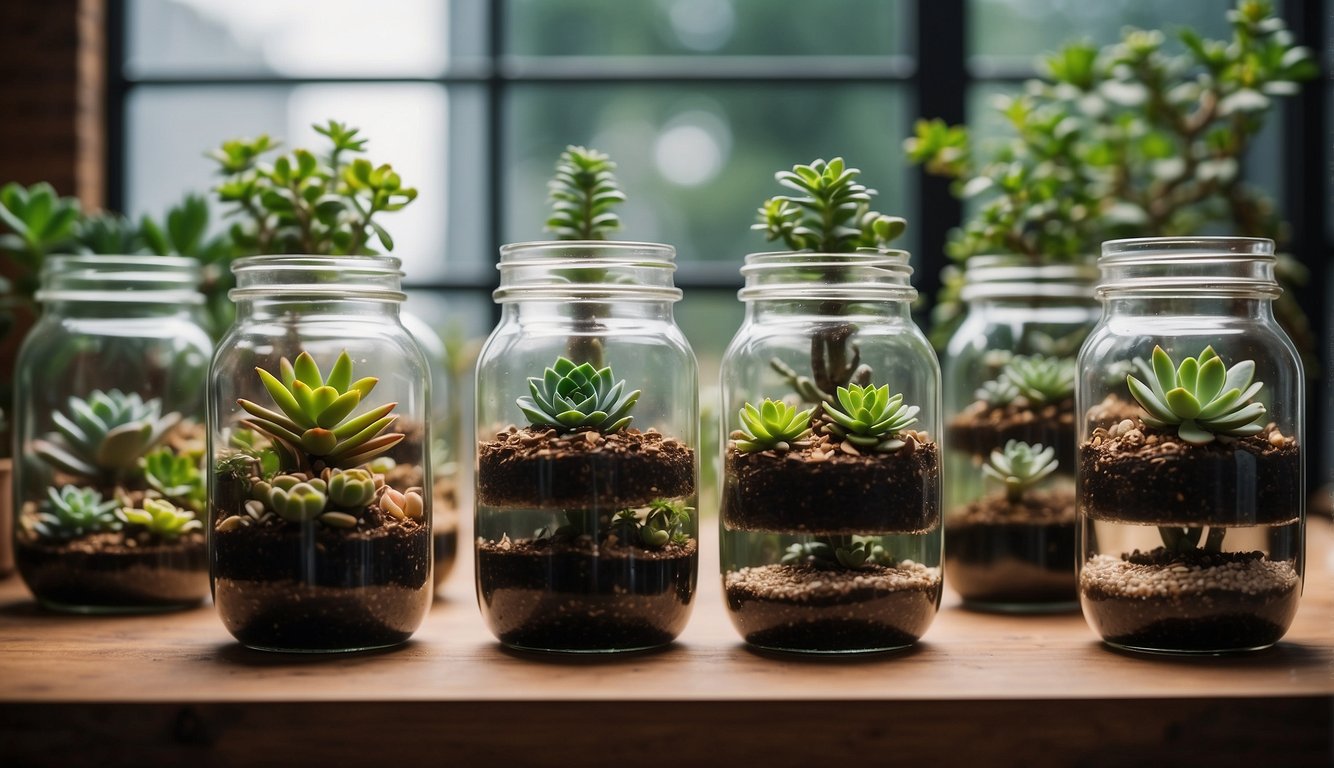
As with any type of plant propagation, there are common issues that can arise when propagating succulents in water. Here are some of the most common issues and how to deal with them.
Dealing with Root Rot and Pests – Propagating Succulents in Water
Root rot is one of the most common issues that can arise when propagating succulents in water. Root rot occurs when the roots of the plant are constantly submerged in water, which can cause them to rot. To avoid root rot, it is important to make sure that the water is changed frequently and that the plant is not left sitting in water for too long. If you notice any signs of root rot, such as brown or black roots, it is important to remove the plant from the water immediately and let it dry out before attempting to propagate it again.
In addition to root rot, pests can also be a problem when propagating succulents in water. Common pests include mealybugs, spider mites, and aphids. To avoid pests, it is important to keep the water clean and to inspect the plant regularly for signs of infestation. If you do notice any pests, you can try washing the plant with a mild soap and water solution or using a natural pest control method, such as neem oil.
Understanding Slow or No Root Growth
Another common issue when propagating succulents in water is slow or no root growth. This can be caused by a number of factors, including pathogens in the water, lack of nutrients, or improper temperature. To avoid slow or no root growth, it is important to make sure that the water is clean and free of pathogens, and to add a small amount of fertilizer to the water to provide nutrients to the plant. It is also important to make sure that the plant is kept in a warm, sunny location to encourage root growth.
In summary, propagating succulents in water can be a fun and rewarding process, but it is important to be aware of the common issues that can arise. By taking steps to avoid root rot and pests, and by providing the plant with the proper nutrients and temperature, you can ensure that your succulent cuttings will grow strong, healthy roots.
Varieties and Species-Specific Tips – Propagating Succulents in Water
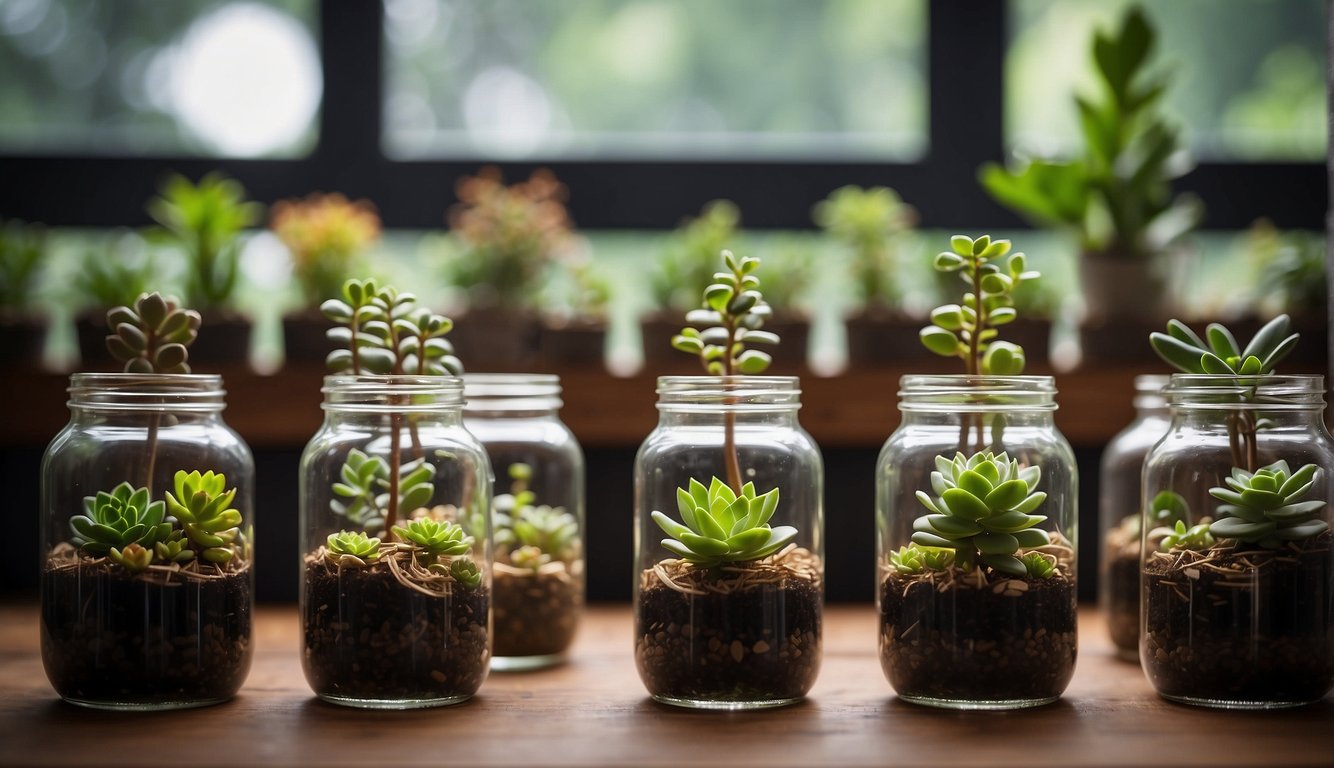
As I have mentioned earlier, propagating succulents in water is a great way to expand your collection. However, not all species of succulents are suitable for water propagation. In this section, I will discuss some of the popular varieties of succulents and species-specific tips for propagating them in water.
Echeveria and Graptoveria
Echeveria and Graptoveria are popular rosette-forming succulents that are easy to propagate. To propagate Echeveria and Graptoveria in water, you can use leaf cuttings or offsets. It is essential to use a healthy leaf or offset for propagation. Make sure that the leaf or offset is not damaged or diseased.
Once you have selected a healthy leaf or offset, place it in a jar of water, making sure that the base of the leaf or offset is submerged in water. Within a few weeks, you should see roots forming from the base of the leaf or offset. Once the roots are about an inch long, you can transplant the leaf or offset into well-draining soil.
Sedum and Aeonium
Sedum and Aeonium are another popular variety of succulents that can be propagated in water. To propagate Sedum and Aeonium in water, you can use stem cuttings or offsets. It is essential to use a healthy stem or offset for propagation. Make sure that the stem or offset is not damaged or diseased.
Once you have selected a healthy stem or offset, place it in a jar of water, making sure that the base of the stem or offset is submerged in water. Within a few weeks, you should see roots forming from the base of the stem or offset. Once the roots are about an inch long, you can transplant the stem or offset into well-draining soil.
Jade Plants and Cacti
Jade plants and cacti are not suitable for water propagation. These succulents are prone to root rot, and propagating them in water can increase the risk of root rot. Instead, it is best to propagate these succulents using stem cuttings.
To propagate Jade plants and cacti using stem cuttings, select a healthy stem and cut it at a 45-degree angle. Allow the cutting to dry for a few days before planting it in well-draining soil. Make sure that the soil is moist but not waterlogged.
Propagating succulents in water can be an easy and fun way to expand your collection. However, it is essential to choose the right species of succulents for water propagation and follow the species-specific tips for successful propagation.
Aftercare and Maintenance – Propagating Succulents in Water
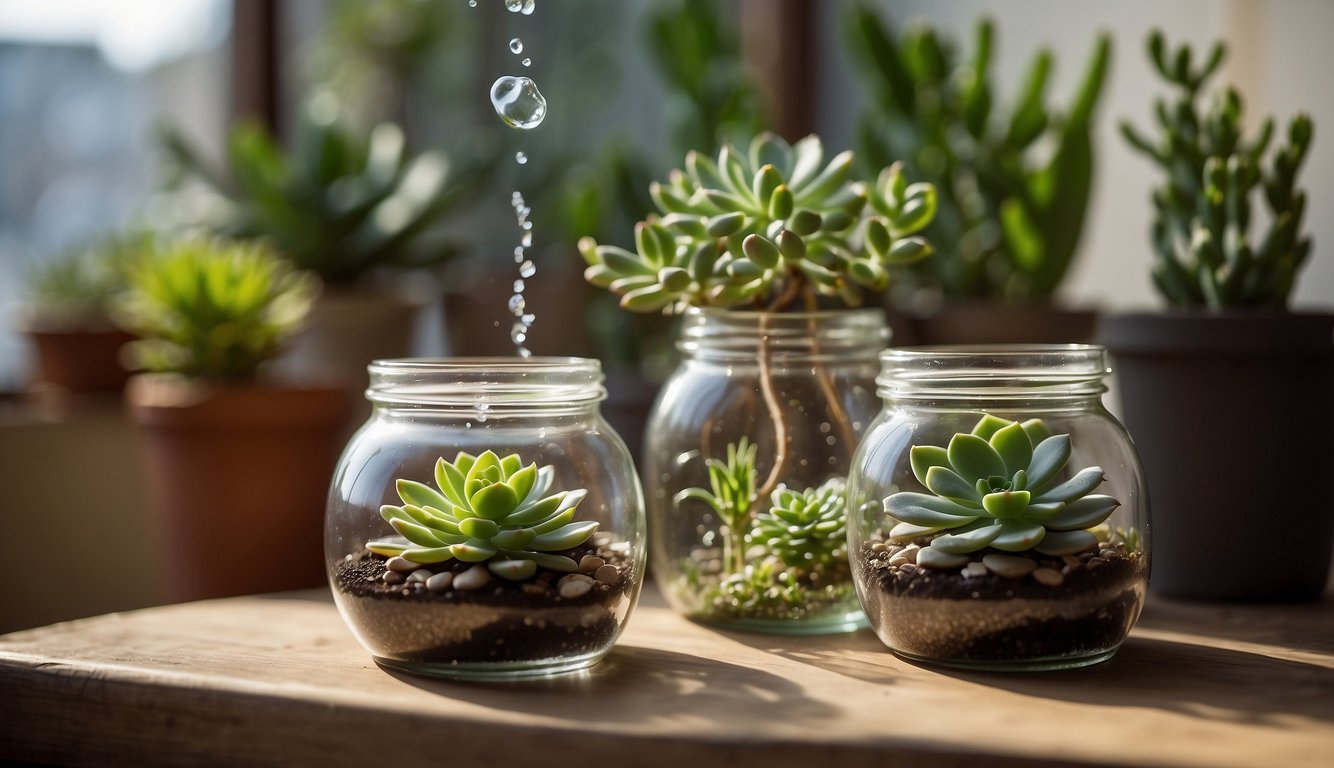
Watering Schedule for Newly Potted Succulents – Propagating Succulents in Water
Once you have successfully propagated your succulent cuttings in water and transplanted them into soil, it is important to establish a watering schedule to help them thrive. One of the most common mistakes that people make when caring for succulents is overwatering them. As a general rule, it is better to underwater than overwater succulents.
For the first week after transplanting, it is best to avoid watering your newly potted succulents. This will give them time to adjust to their new environment and recover from any damage that may have occurred during the propagation process. After the first week, you can begin watering your succulents once a week. However, the frequency of watering will depend on the type of succulent and the conditions in your home.
To determine when to water your succulents, you should check the soil moisture level. Insert a finger into the soil up to the first knuckle. If the soil feels dry, it is time to water your succulents. If the soil is still moist, you can wait a few more days before watering again.
Fertilizing and Long-Term Care – Propagating Succulents in Water
In addition to proper watering, succulents also require fertilization and long-term care to stay healthy. Fertilizing your succulents every 2-3 months will help them grow and produce new leaves. You can use a balanced, water-soluble fertilizer that is specifically designed for houseplants. Be sure to follow the instructions on the label carefully to avoid overfertilizing and damaging your plants.
Long-term care for succulents includes pruning, repotting, and pest control. Pruning your succulents will help them maintain their shape and prevent them from becoming too leggy. You can also propagate new plantlets from the cuttings. Repotting your succulents every 1-2 years will provide them with fresh soil and more space to grow. When repotting, be sure to use a well-draining soil mix that is specifically designed for succulents.
Finally, it is important to keep an eye out for pests such as mealybugs, spider mites, and scale insects. These pests can damage your succulents and spread to other plants in your home. If you notice any signs of pests, you can use an insecticidal soap or neem oil to treat the infestation.
The Symbiotic Relationship: Propagating Succulents in Water and The Herb Prof
Let’s dive into the world of succulents and how they relate to our favorite herbal haven, theherbprof.com. Intrigued? Let’s get started!
First off, propagating succulents in water is a journey of patience and care. It’s about turning a tiny cutting into a thriving plant. Sounds familiar? That’s because theherbprof.com does the same for your herbal knowledge!
Next, both succulents and theherbprof.com are all about adaptability. Just like succulents thrive in various conditions, theherbprof.com caters to all levels of herbal enthusiasts.
Finally, they both aim to enrich our lives. Succulents add a touch of green to our homes, while theherbprof.com empowers us with the wisdom of herbs.
So, there you have it! Propagating succulents in water and theherbprof.com are two peas in a pod. They both symbolize growth, adaptability, and enrichment. Now, isn’t that a succulent piece of information to share at your next garden party? Keep growing, folks!
References – Propagating Succulents in Water
Little Herb Encyclopedia, by Jack Ritchason; N.D., Woodland Publishing Incorporated, 1995
The Ultimate Healing System, Course Manual, Copyright 1985, Don Lepore
Planetary Herbology, Michael Tierra, C.A., N.D., Lotus Press, 1988
Handbook of Medicinal Herbs, by James A. Duke, Pub. CRP Second Edition 2007
The Complete Medicinal Herbal, by Penelope Ody, Published by Dorling Kindersley
Check the Following Articles!
Garden Tower 2 Review: The Vertical Gardening System
How to Propagate Thanksgiving Cactus: The Step-by-Step
Best Prepper Garden: How to Be Self-Sufficient
Frequently Asked Questions – Propagating Succulents in Water
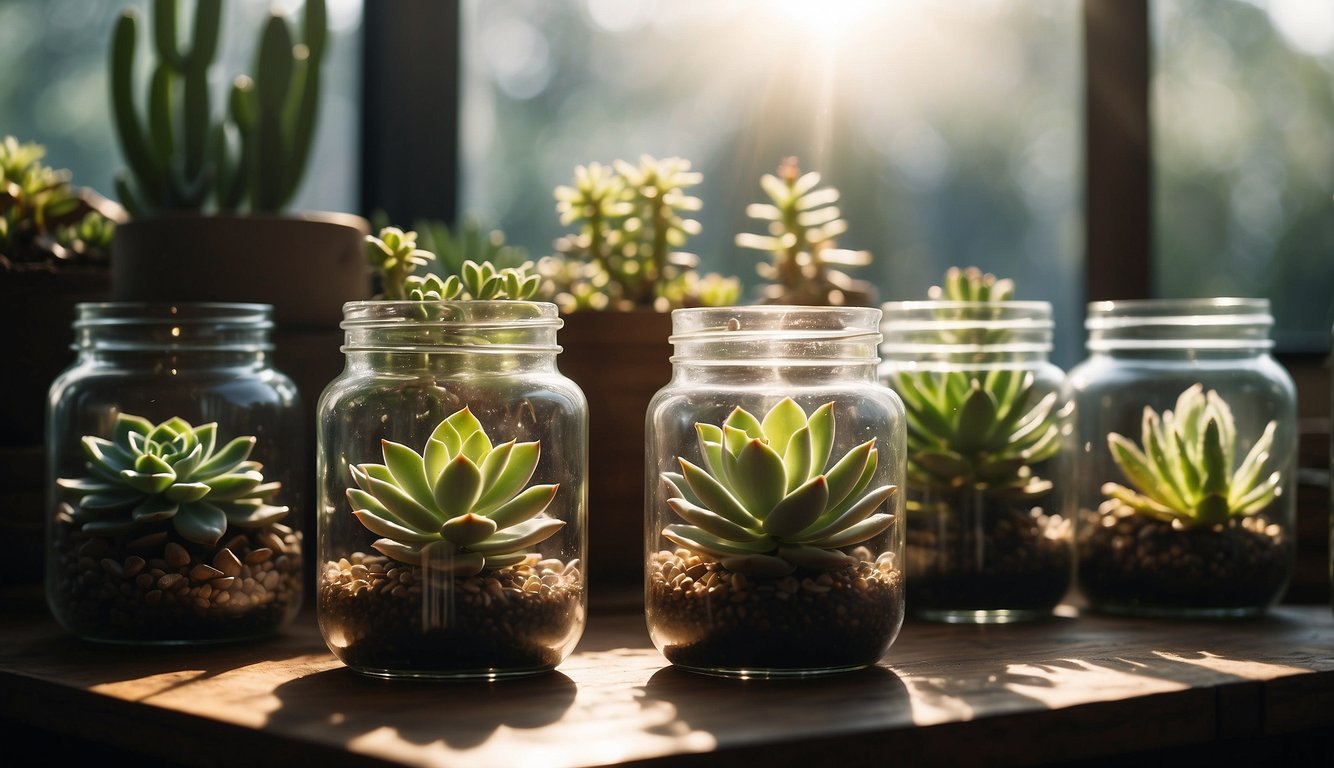
Which succulent species are suitable for water propagation?
Most succulent species can be propagated in water, but some are more suitable than others. Succulents with fleshy leaves and stems, such as Echeveria, Sedum, and Crassula, are ideal for water propagation. However, succulent species with thin leaves and stems, such as Aloe and Haworthia, may not be suitable for water propagation.
How do you propagate succulent cuttings in water?
To propagate succulent cuttings in water, follow these steps:
- Take a healthy cutting from the parent plant.
- Remove the leaves from the bottom 1-2 inches of the stem.
- Place the cutting in a jar or vase filled with clean water, making sure that the bottom of the stem is submerged.
- Place the jar or vase in a bright, warm location, but not in direct sunlight.
- Change the water every few days to prevent bacterial growth.
- Wait for the roots to develop, which may take several weeks.
- Once the roots are at least 1-2 inches long, transfer the cutting to soil.
Is it necessary for succulent leaves to develop a callus before water propagation?
It is not necessary for succulent leaves to develop a callus before water propagation. However, allowing the cuttings to callus over for a day or two can help prevent the cuttings from rotting in water.
What are the differences between propagating succulents in water versus soil?
Propagating succulents in water is faster than propagating them in soil because the cuttings can absorb water and nutrients more easily. However, water propagation can also be riskier because the cuttings are more prone to rotting. Propagating succulents in soil is slower but more reliable because the soil provides a stable environment for the cuttings to grow.
How can you accelerate the propagation process for succulents?
To accelerate the propagation process for succulents, you can use rooting hormones, which stimulate root growth in cuttings. However, rooting hormones are not necessary for water propagation, and some succulent species may not respond well to them.
Can succulents be propagated without the use of rooting hormones?
Yes, succulents can be propagated without the use of rooting hormones. Water propagation is a natural way to propagate succulents without the use of chemicals or hormones. However, rooting hormones can help accelerate the propagation process and increase the success rate of propagation.
